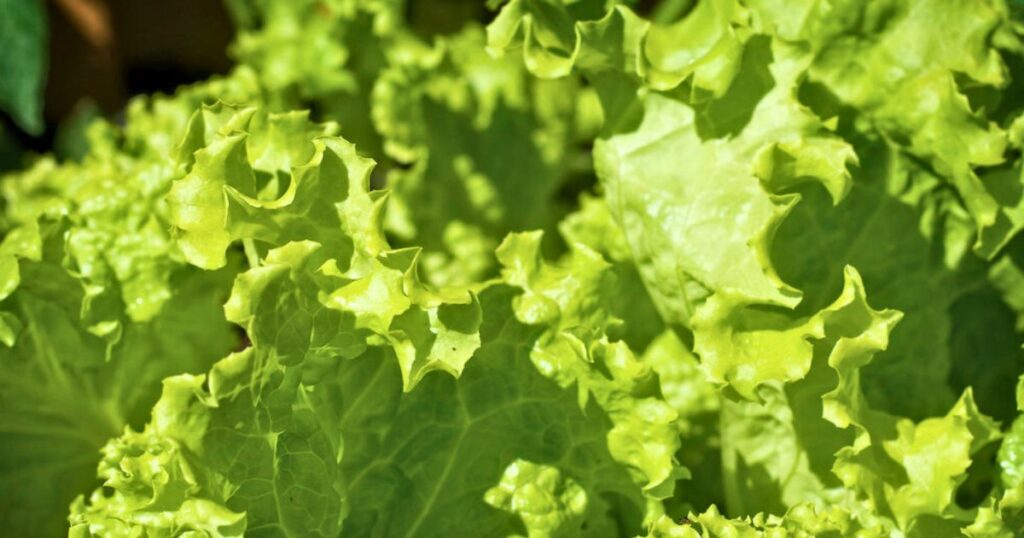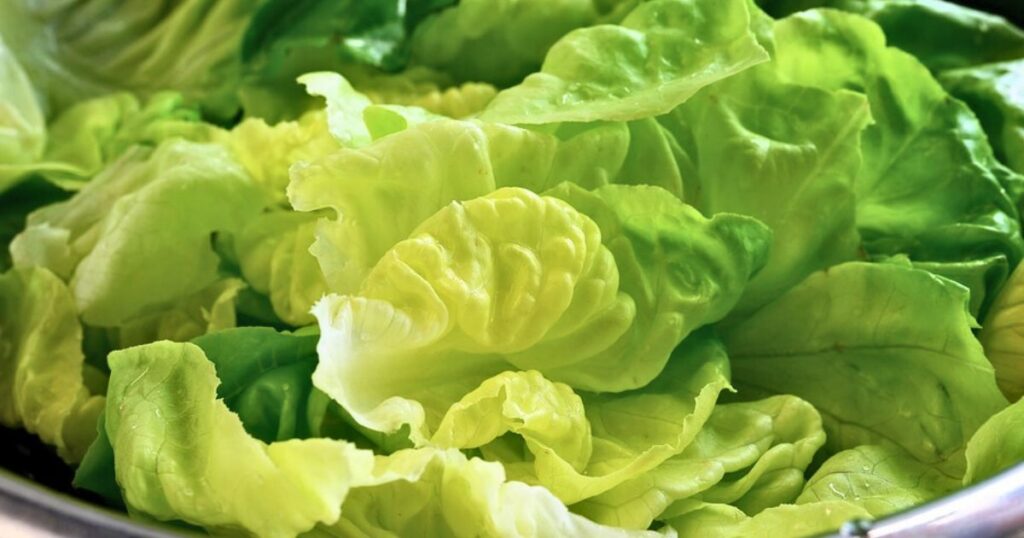
Lettuce is a type of leafy vegetable that is popular worldwide. It’s famous because it’s widely available, versatile, and commonly used in salads, sandwiches, and wraps.
People enjoy lettuce for its refreshing crunch, mild taste, and ability to add texture to dishes.
But can hamsters enjoy them too?
Yes, hamsters can eat lettuce, but there are a few things to keep in mind. Lettuce can be given to hamsters as a treat in small amounts. It’s important not to feed them too much lettuce because it can cause digestive issues. Hamsters have sensitive stomachs, so it’s best to introduce lettuce gradually and observe how they tolerate it.
Different types of lettuce have varying nutritional values, and some types, like iceberg lettuce, have a lower nutrient content compared to others.
Table of Contents
Can Hamsters Eat Lettuce?
Hamsters can safely eat lettuce but in moderation. They are highly nutritious for us, but it’s not the same for hamsters.
Romaine lettuce is generally considered safe for hamsters and can be given as a treat in small quantities. However, iceberg lettuce is not recommended as it lacks significant nutritional value. It’s advisable to avoid offering iceberg lettuce to hamsters.
When feeding lettuce to your hamster, it’s crucial to provide fresh, rinsed lettuce leaves. Remove any wilted or spoiled parts before offering it to them.
Remember that while lettuce can be a part of a hamster’s diet, it should not replace their main food source, which is typically a pelleted hamster diet.
Providing a varied diet with a mix of fresh vegetables, fruits, and pellets is important to keep your hamsters healthy.
Read this too! Can Hamsters Eat Kale? [Serving, Risks & More]
How Much Lettuce Should I Give My Hamster?
When it comes to feeding lettuce to your hamster, it’s important to do so in moderation. Lettuce can be a nice addition to their diet, but too much of it can cause digestive issues for your furry friend.
A thumb rule is to give your hamster a small amount of lettuce, about a few leaves, two to three times per week.

This ensures they get some variety in their diet and enjoy the fresh vegetables.
It’s important to choose the right type of lettuce for your hamster. Opt for varieties like romaine lettuce or leaf lettuce, as they are safer options. Avoid iceberg lettuce, as it doesn’t have as many nutrients and can cause some stomach problems for hamsters.
Before feeding lettuce to your hamster, make sure to wash it thoroughly to remove any dirt or chemicals. Also, chopping the lettuce into small pieces for your hamster to eat easily.
Is Lettuce Good for Hamsters?
Yes, lettuce can provide several health benefits for hamsters when fed in moderation. It serves as a great source of hydration and contains essential vitamins and minerals.
However, it’s important to note that too much lettuce can lead to various health issues.
So be cautious!
A typical serving (1 cup, shredded, approximately 36 grams) contains:
- Calories: 5
- Carbohydrates: 1 gram
- Fiber: 1 gram
- Protein: 0.5 grams
- Fat: 0 grams
Other health benefits of lettuce may include:
Hydration: Lettuce has a high water content, which can help keep your hamster hydrated, especially during warmer months or if they have diarrhea.
Vitamin C: Lettuce contains vitamin C, an essential nutrient that plays a crucial role in supporting the immune system and preventing scurvy in hamsters.
Fiber: Lettuce is a good source of dietary fiber, which aids in digestion and helps maintain a healthy gastrointestinal tract.
Antioxidants: Lettuce contains various antioxidants, such as beta-carotene, which can help reduce oxidative stress and support overall health.
Remember, while lettuce can be a healthy addition to your hamster’s diet, it should be introduced gradually and offered in small amounts to avoid digestive upset.
Potential Risks of Feeding Lettuce to Hamsters
When it comes to feeding lettuce to hamsters, there are a few potential risks that you should be aware of
Digestive Issues
Hamsters have delicate tummies, and eating too much lettuce, especially if they’re not used to it, can give them tummy troubles. It might make them have diarrhea or upset their little stomachs. So, it’s important to give them lettuce in small amounts and see how their bodies react.
Pesticides
Sometimes lettuce, like other vegetables, can have pesticides on them. Pesticides are chemicals that are used to kill bugs or keep plants healthy. These pesticides can be harmful to hamsters if they eat lettuce that has them.
That’s why it’s important to wash the lettuce thoroughly before giving it to your hamster or buy organic lettuce, which is grown without using pesticides.
Choking Hazard
Hamsters have tiny mouths and can accidentally bite off more than they can chew, especially with crisp lettuce leaves. This can lead to choking. To avoid this, it’s best to cut the lettuce into small, manageable pieces for your hamster to nibble on.
Can Lettuce Cause Digestive Issues in Hamsters?
Yes, lettuce can potentially cause digestive issues in hamsters if given in excessive amounts or if they’re not used to eating it.
While lettuce has high water content and some fiber, which can be beneficial, it can also have a laxative effect on hamsters, leading to loose stools or diarrhea.

Hamsters have sensitive digestive systems, and sudden changes in their diet can upset their stomachs. If you introduce lettuce too quickly or give them large quantities, it may cause digestive problems.
Additionally, some types of lettuce, such as iceberg lettuce, have higher water content and lower nutritional value compared to other leafy greens.
So, it’s recommended to offer small, washed and thoroughly dried lettuce leaves as an occasional treat rather than a significant portion of their daily diet.
What Types of Lettuce Can Hamsters Eat?
If you want to feed lettuce to your hamsters, it’s important to understand the type of lettuce available in the market.
There are a few options that are safe and healthy for them.
- Romaine Lettuce: Hamsters can enjoy romaine lettuce! It’s a type of lettuce that has long, crunchy leaves. Romaine lettuce is a good choice because it has a decent amount of nutrients and is generally well-tolerated by hamsters.
- Butter Lettuce: Another lettuce that hamsters can eat is butter lettuce. It has soft, tender leaves and a mild flavor. Hamsters might find it tasty and enjoy munching on it.
- Red or Green Leaf Lettuce: These types of lettuce are also safe for hamsters. They have nice, leafy textures and provide some hydration and fiber for your little furry friend.
It’s important to remember that while these lettuces are safe for hamsters, they should be given in moderation. Too much lettuce, even the safe types, can cause digestive problems for hamsters. So it’s best to offer small amounts as an occasional treat rather than a large portion of their diet.
How Should I Prepare Lettuce for My Hamster?
Preparing lettuce for your hamster is a simple and easy process; however, there are a few things to remember.
Here’s a simple method for you
- First, you’ll want to wash the lettuce thoroughly to remove any dirt, pesticides, or chemicals that might be on the leaves. You can do this by placing the lettuce under cool running water and gently rubbing the leaves with your hands. Make sure to get rid of any dirt or debris.
- Dry it: After washing, it’s important to dry the lettuce properly. Hamsters don’t like wet or damp food, so you want to remove as much moisture as possible. You can use a clean towel or paper towel to pat the lettuce dry gently. Just make sure it’s not dripping wet before giving it to your hamster.
- Chopping the lettuce in small pieces will make it easier for your hamster to eat and prevent any choking hazards. You can use a clean and sharp knife or tear the lettuce into small strips by hand.
That’s it! With these simple steps, you can prepare lettuce for your hamster. Always make sure to handle the lettuce with clean hands and store any leftover lettuce in the refrigerator to keep it fresh.
Remember, too much lettuce can cause digestive issues for your hamster, so it’s best to give it in moderation.
Can Hamsters Eat Other Leafy Greens Besides Lettuce?
Hamsters can enjoy a variety of leafy greens besides lettuce.
Here are some healthy options:
- Spinach: Hamsters can have spinach, but it should be given in small amounts. Spinach is packed with nutrients like iron and vitamin C, but it also contains something called oxalates. Oxalates, when eaten in large quantities, can be harmful to hamsters.
- Kale: Hamsters can eat kale too! Kale is another leafy green that’s rich in nutrients. It contains vitamins A, C, and K, as well as minerals like calcium, just like spinach.
- Romaine Lettuce: Besides the lettuces I mentioned earlier, hamsters can also enjoy romaine or cos lettuce. These types of lettuce have crunchy leaves and provide some hydration and fiber for your hamster.
- Swiss Chard: Swiss chard is another leafy green that hamsters can eat. It’s colorful and has a slightly bitter taste. It’s a good source of vitamins A, C, and K, as well as minerals like calcium and iron.
Remember, when introducing any new leafy greens to your hamster’s diet, it’s important to start with small amounts and observe how your hamster reacts. Some hamsters may have preferences for certain greens, while others may not enjoy them as much.
Final Thoughts
To sum up, hamsters can eat lettuce, but it should be given in moderation as an occasional treat Lettuce can provide some hydration and nutrients for hamsters, but too much can lead to digestive issues. Introducing new foods slowly and observing your hamster’s reaction is important to ensure they tolerate it well.
While lettuce is safe for hamsters, it’s also good to offer a variety of other leafy greens to provide a balanced diet.
Before you leave, here are some more helpful articles:
